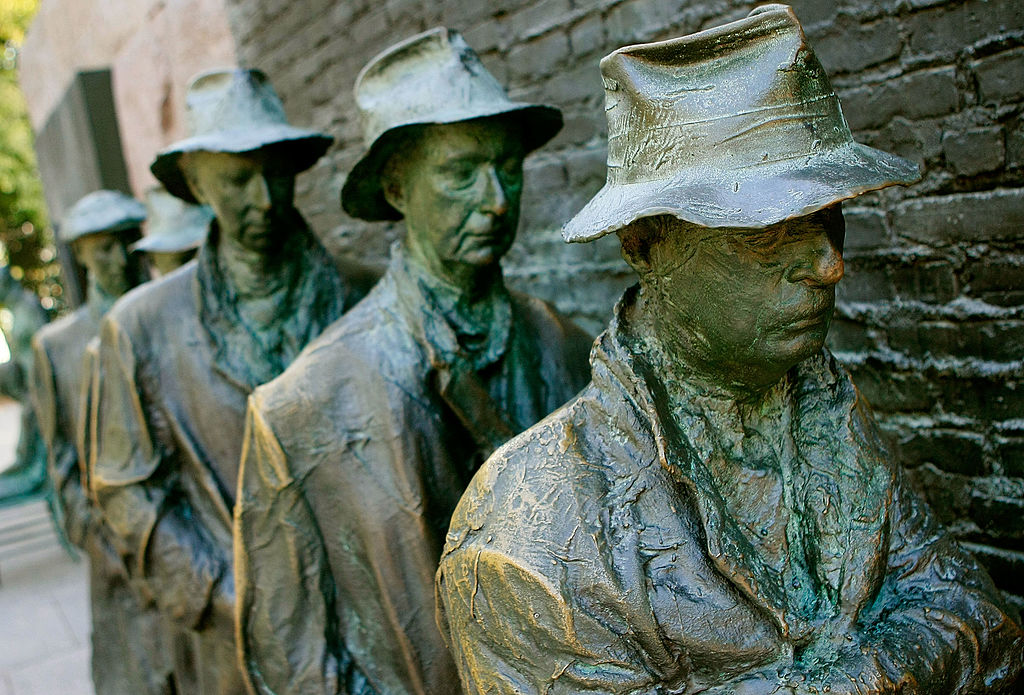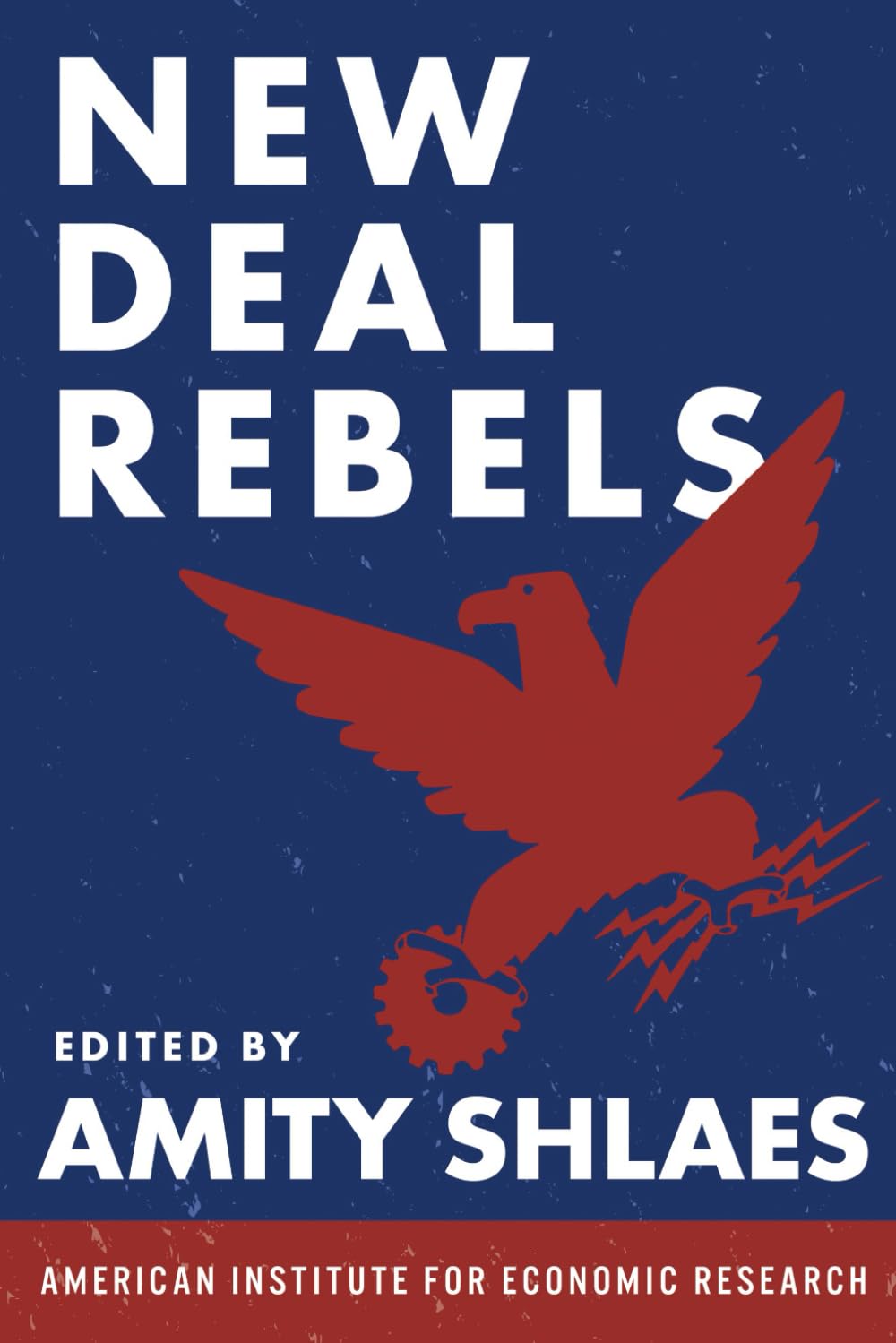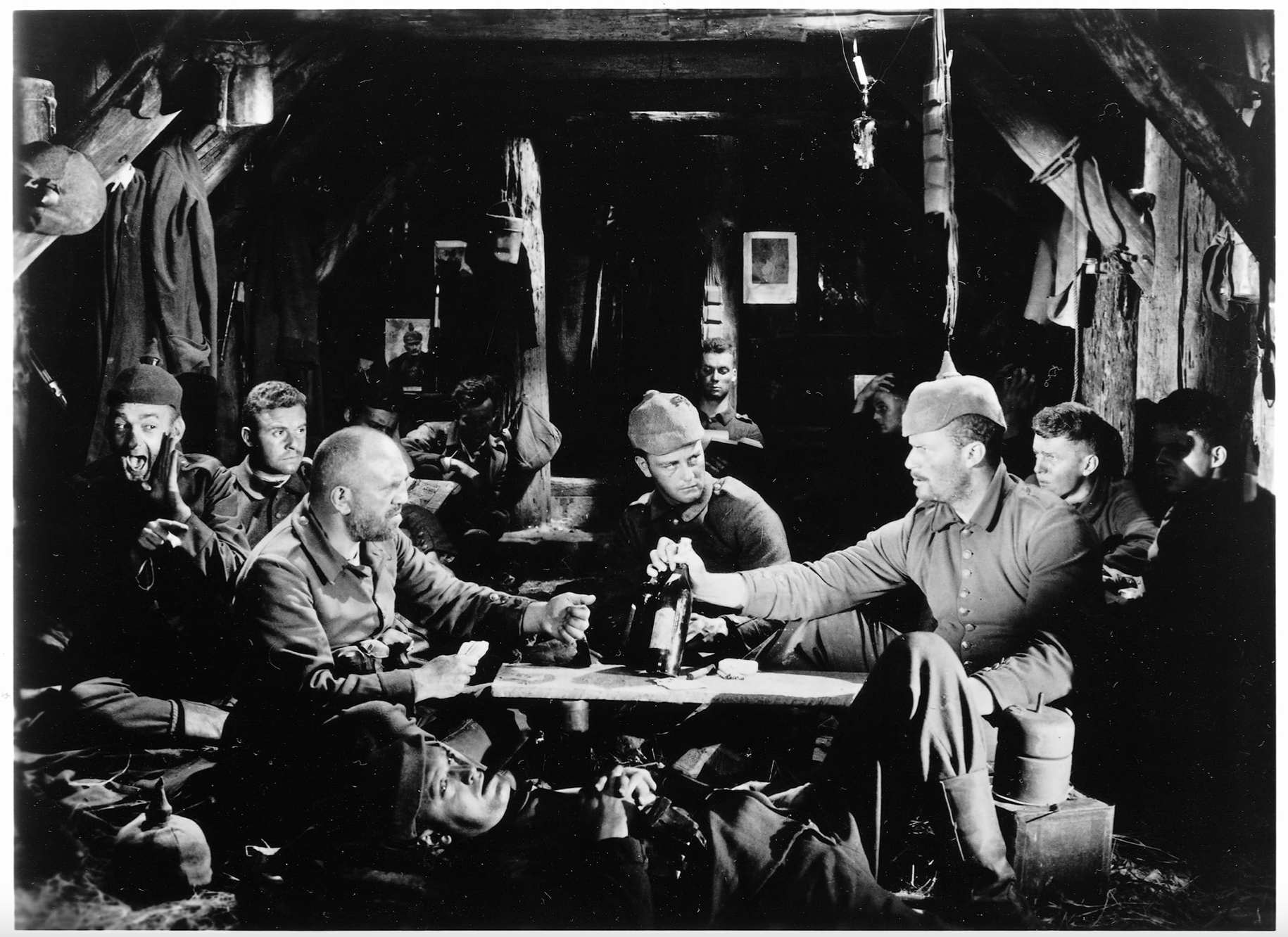Back in the 1950s when I was in high school, mainstream history textbooks represented Franklin Roosevelt’s New Deal as simply a natural outgrowth of the evolving American “liberal” tradition. This portrayal resulted from the successful endeavor of progressive historians such as Richard Hofstadter to write the history of progressivism—eliding the critical transformation in the meaning of liberalism that had won general acceptance during the Roosevelt administration, from the Founders’ constitutional liberalism, based on limited government enforced by separation of powers, checks and balances, federalism, and a written Constitution, to a doctrine favoring ever-expanding government, dominance by an activist president and a growing bureaucracy, and little regard for constitutional limitations. (See Bradley Watson’s 2020 study Progressivism: The Strange History of a Radical Idea.)
So successful was the acceptance of progressive government as the legitimate meaning of American constitutionalism that Republican president Dwight Eisenhower made no attempt to cut back on New Deal policies. And when 1964 Republican presidential nominee Barry Goldwater did challenge them—notably, imprudently calling for the repeal of Social Security—he instantly wrote off his chances of election. Only cranks, it appeared, would still try to repeal FDR’s legacy; instead, his successor Lyndon Johnson would extend it, as “the Great Society” (the title of another book by Shlaes). And the Obama and Biden presidencies have expanded the realm of progressive government still further, vastly increasing federal debt, enacting sweeping legislation, such as Obamacare, without congressional deliberation, and subjecting the American people to an ever-growing bureaucracy, left free, with only occasional judicial interference, to interpret broadly written statutes based on its members’ discretion.
Only over the last couple of decades have economists and political scientists of impeccable scholarly credentials—including Burton Folsom, Jr. (New Deal or Raw Deal?); Jim Powell (FDR’s Folly), and most prominently Amity Shlaes (The Forgotten Man) mounted a serious challenge to the New Deal consensus.
Shlaes borrowed her title from Roosevelt, who promised in a 1932 address to elevate the condition of supposedly overlooked poor people, both urban and rural, amid the Depression, in a permanently transformative way. But Shlaes tracks the term to its originator, the late-nineteenth-century Yale sociologist William Graham Sumner, who identified the real “forgotten man” as the one (“C”) left to pay the bills to finance schemes of governmental redistribution concocted by “A” and “B,” supposedly for the sake of the common good. (Sumner’s essay serves as the opening selection in the present volume.) In her previous book, Shlaes demonstrated how the New Deal, far from elevating the status of ordinary Americans, left them worse off: with unemployment, after a temporary dip, rising by the late 1930s to its pre-FDR high; business investment deterred by heavy taxation and unpredictable government policies; and a general pessimism about America’s economic future.
In New Deal Rebels, Shlaes supplements her earlier work by assembling fifty-three selections, most from the 1930s and including excerpts from a couple of Supreme Court decisions and even a hilarious poem by Ogden Nash, most of which challenge the New Deal and its underlying principles. Contrary to her subtitle, not all the authors included were truly “rebels”: among the selections are a couple of friendly letters of advice from the British economist John Maynard Keynes, who shared FDR’s goals while sometimes questioning his tactics, and a glowing account by a Dutch journalist of the benefits that the Tennessee Valley Authority brought to a backward region of the Southeast, even as she noticed the innate conservatism of American workers, in contrast to their European counterparts.
As Shlaes makes clear in her introduction, the roots of the New Deal, with Roosevelt’s call for “bold, persistent experimentation,” ostensibly to meet the challenge of the Depression, long preceded that event. Decades earlier, state governments, inspired by the progressive movement, had enacted laws limiting workers’ hours and wages. In the 1905 case of Lochner v. New York, the Supreme Court ruled unconstitutional a state law applying such regulations to bakeries, since it violated the freedom of contract guaranteed by the Fourteenth Amendment. (For the anticompetitive animus underlying that law, profiting large bakery companies at the expense of small ones, see David E. Bernstein’s 2011 study Rehabilitating Lochner.) But the First World War afforded Woodrow Wilson the occasion to extend the progressive program to the national level, for instance, nationalizing the railroads and raising the top federal income tax rate to 77 percent.
In a previous biography of the long-neglected President Calvin Coolidge, Shlaes demonstrated how his policies of fiscal and monetary restraint and fidelity to the Constitution during the 1920s (mocked by Roosevelt and subsequent historians) brought unparalleled prosperity to the American people. However, the 1929 stock market crash, whose economic effects were exacerbated by anti–free market policies pursued by Coolidge’s successor Herbert Hoover (the Davis–Bacon Act mandating high wages for federal contractors; the ruinous Smoot–Hawley Tariff) finally gave progressives the opportunity they had sought to permanently transform America’s political-economic system. And Roosevelt, with his charismatic appeal, conveyed especially through his Fireside Chats on the radio, was able to convince popular majorities that his inconsistent and sometimes downright wacky schemes would improve their situations—even though they didn’t. These included, for instance, the National Industrial Recovery Act [NRA], which penalized businesses for lowering their prices, and even for allowing poultry buyers to choose their own live chickens—a law unanimously ruled unconstitutional by the Supreme Court; and agricultural legislation that required farmers to bury their crops and slaughter “excess” farm animals, even as city dwellers assembled in bread lines. Black Americans particularly suffered from Roosevelt’s policies, as John P. Davis, an African American attorney, pointed out, with the NRA “codes” fixing wage differentials between black and white workers in favor of the latter, the reduction in tilled farm acreage under the Agricultural Adjustment Administration causing the dismissal of black tenant farmers and laborers, and the enforcement of racial segregation in federally financed programs.
As Garet Garrett, editor of the Saturday Evening Post and one of the most astute critics included in this volume, put it in a review of the New Deal’s first five years, Roosevelt’s policies borrowed arbitrarily from various “Old World” systems (social security, government planning, corporatism), all while “crippl[ing] the free competitive system” that had elevated the American economy over all others. The “only consistent thing” Garrett found in Roosevelt’s policies during his first term was “the delusion that unlimited production is a social curse” (a theme openly stated, I add, in Roosevelt’s 1932 campaign address to the Commonwealth Club of San Francisco—a group of business leaders, no less). As Garrett put it in a 1953 overview of FDR’s policies, the one idea that united all of Roosevelt’s policies was the “transfer of power” from earlier sorts of democratic leaders to a new “elite”—that is, Roosevelt and the highly educated members of his so-called Brain Trust of advisors.
Exemplary of the credulousness on which Roosevelt’s endeavors depended was the reply of his wife Eleanor, as dissected by a New York journalist, to a correspondent who asked why the government was placing federal notes supposedly meant to finance the new Social Security system into an “Old-Age Reserve account” and then spending the proceeds on current expenses instead of investing them into “an income-producing bond or stock” as a private business would have done. In response to the writer’s exposé of Social Security funding as a Ponzi scheme, the First Lady explained that future contributors could be counted on to make up the lost funds, that any investment is a “gamble,” and that she herself would “take a chance on those government notes . . . and pay my taxes cheerfully.”
Among the most incisive critics of the New Deal anthologized here were men of modest backgrounds, unlike Roosevelt and his supposedly learned advisors, heirs of the long progressive tradition.
The correspondent’s prescient criticism of the Social Security financing system was one of numerous observations that are no less applicable to today’s government policies. To begin, one might note that the Smoot–Hawley Tariff, passed by a Republican-controlled Congress, anticipated Donald Trump’s promised 10 percent tariff on all imported goods, likely to have equally damaging effects, while Roosevelt’s torpedoing of the London Economic Conference was echoed by Trump’s refusal to join the Asia-Pacific Trade Agreement. FDR’s “fabulous” $4,880,000,000 “Emergency Relief Appropriation Act” of 1935, which entailed enormous “boondoggling,” as Garrett puts it, amounted to a “surrender” of “control of the public purpose” to the president by “authorizing him to spend it in his own discretion,” just as Joe Biden’s ostensibly “recovery” enactments have done. Similarly, the president of the American Bar Association, responding to Roosevelt’s 1934 boast that the “tremendous readjustment of our national life” he had undertaken was “being accomplished peacefully,” described it as an “accelerated” move into “administrative absolutism,” achieved through what the European historian Jacob Burckhardt had once called “the domestication of individuality.” Keynes, in a private letter to the president, indeed advised him that rather than denounce businessmen as he was wont to do, he should simply treat them as tame “domestic animals,” to whom he could “do anything you liked” with “a kind word.” How many businessmen today will organize to challenge the expanding Democratic regulatory, tax, and DEI agendas rather than quietly comply thanks to what Keynes called their fear of “the glare of publicity”?
In another trenchant observation, former Democratic presidential candidate John W. Davis denounced Roosevelt’s 1935 message to Congress, advocating higher, more progressive taxation in order to encourage “a wider distribution of wealth,” observing that though he himself had been a member of the Democratic Congress that in 1913 had enacted the first graduated income tax, he had done so only to finance the government’s needs, not for the communistic purpose of income redistribution. (Recall Barack Obama’s acknowledgment during the 2008 campaign that he would favor raising taxes on the rich just to combat “inequality,” even if the result were to decrease the nation’s wealth and hence everyone’s well-being.)
Davis was one of two former Democratic presidential candidates to turn against the New Deal, the other being the popular former New York Governor Al Smith, who at the start of the 1936 campaign warned of the harmful effects of Roosevelt’s demagogic class-based, anti-business rhetoric, stressing that “there can be no permanent prosperity in this country until industry is able to employ labor, and there certainly can be no permanent recovery upon any governmental theory of soak the rich or soak the poor.” Smith, despite his plebeian origins, in contrast to Roosevelt’s aristocratic ones, recognized the truth in supply-side economics.
It is noteworthy, indeed, that among the most incisive critics of the New Deal anthologized here were, like Smith, men of modest backgrounds, unlike Roosevelt and his supposedly learned advisors, heirs of the long progressive tradition. To win support for his program, Roosevelt even used funds from his Works Progress Administration to woo artists and writers by giving them jobs, thereby producing works that praised the administration’s incoherent anti-agriculture program, or warning that without the New Deal America might be taken over by fascism. Shades of All Things Considered?
But as the Chase Bank economist Benjamin Anderson subsequently observed in his history of the New Deal, the decisive fault in progressivism was its assumption that expert “planners” knew better than ordinary people how best to advance their interests, with the former endeavoring to “play God.” Anderson’s insight was further developed by the Nobel Prize–winning economist Friedrich Hayek, author of a 1941 essay that Shlaes includes titled “Planning, Science, and Freedom,” subsequently developed in his 1944 classic The Road to Serfdom.
In the end, it wasn’t Roosevelt’s policies that lifted Americans out of the Depression. After World War II provided full employment, the postwar Republican-majority Congress (the first in sixteen years) set off an economic boom by remedying the New Deal’s greatest excesses, following a program outlined by Ohio Senator Robert Taft that Shlaes includes in her last section: reducing taxes and unnecessary regulations, authorizing states to establish “right to work” laws freeing workers from compulsory union membership, and routing federal assistance for health, housing, and education through state and local governments. As a coda, Shlaes includes the majority Supreme Court opinion in Youngstown Sheet & Tube Co. v. Sawyer (1952), which reasserted constitutional limits on presidential power over the economy like the ones Franklin Roosevelt had sought to overthrow.
Along with her previous books, New Deal Rebels constitutes a valuable contribution to the quest to restore understanding of the contemporary prerequisites of political and economic liberty.
















